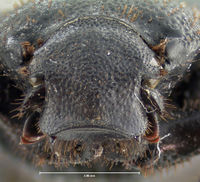Cremastocheilus angularis
| Cremastocheilus angularis | |
|---|---|

| |
| Scientific classification | |
| Kingdom: | Animalia |
| Phylum: | Arthropoda |
| Class: | Insecta |
| Order: | Coleoptera |
| Family: | Scarabaeidae |
| Subfamily: | Cetoniinae |
| Tribe: | Cremastocheilini |
| Genus: | Cremastocheilus |
| Subgenus: | Myrmecotonus |
| Species: | C. angularis |
| Binomial name | |
| Cremastocheilus angularis LeConte, 1857 | |
One of about thirty-five species of myrmecophilous Cremastocheilus. The host ant is presumed to be a species in the genus Myrmecocystus.
Identification
Body black; posterior angles of pronotum large, slightly reflexed; elytra with narrow, elongate punctures, widely separated and open behind; hind tarsi rapidly tapering on the flat side, barely three-fifths as long as the tibiae; tarsal segments compressed.
Distribution
California
Habitat
Biology
There are several candidates (Messor andrei, Formica sp.? and Pogonomyrmex montanus) for the host ant but more work is needed to sort out accidental from true hosts. Since ants drag in dead beetles as prey items, beetles should be alive and the best indicator of the true host is the development of beetle larvae in the ant nest.
Nomenclature
- Cremastocheilus compressipes Casey 1915 Syn.
Type: California. Sacramento Co., Sacramento, no date (Wittick; MCZ), described by LeConte (1857).
Description
References
- Alpert, Gary D. 1994. A Comparative Study of the Symbiotic Relationship Between Beetles of the Genus Cremastocheilus (Coleoptera: Scarabaeidae) and their Host Ants (Hymenoptera:Formicidae). Sociobiology 25(1).
- LeConte J.L. (1857) Report upon the Insects collected on the survey. Explorations and surveys for a railroad route from Mississippi river to the Pacific Ocean. – War Department. Route near the forty-seventh and forty-ninth parallels, explored by I. I. Stevens, governor of Washington Territory, in 1853–'55. Zoological Report: 12:1-72 (40-42)



